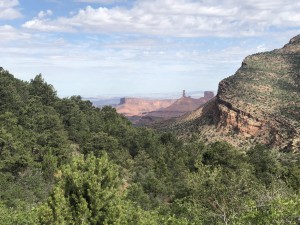In Tony Hillerman’s (and since his death, his daughter Anne’s) detective fiction, the Legendary Lieutenant Joe Leaphorn and Officer Jim Chee solve crimes, mostly murder, on the Navajo Reservation. Chee follows the Navajo Way, and in many books reflects on Harmony, a bedrock value of Navajo spirituality.
As he explains it, our physical, mental, and spiritual health depend on living in harmony with nature, circumstances, and others. The absence of harmony leaves us sick, depressed, and prone to sub-optimal performance.
In mid-July, I listened to Hillerman’s Talking God as I drove through Navajo land on the way to Moab for a week of cycling and hiking. At one point, Chee describes the Navajo predisposition to seek harmony in challenging times. In a drought, he says, most Indian tribes will pray for rain. But Navajos will pray for the knowledge to live in harmony with the drought.
With the start of school only a couple of weeks away, that short passage opened my eyes to the benefits of seeking harmony as a path to teacher well-being, as compared to the more frequently sought after goal of work-life balance.
Harmony and balance are by no means mutually exclusive. But when I think about balancing my professional and personal demands, there’s an implied tension between the two, that paying attention to one comes with the cost of ignoring the other. Maintaining balance requires constant reaction and mid-course correction. It’s tiring.
In Logic & Design in Art, Science & Mathematics, Krome Barratt illustrates the inherent tension in seeking balance when he writes that in the universe balance demands that no energy is lost and none is gained, that, “It can be changed only from one form to another, one location to another, while it’s total remains a constant.” The same could be said of time.
In contrast, harmony implies graceful interdependent flow and interaction of the parts which make up a whole. About which Barratt writes, “Simple harmony occurs when an event is supported, strengthened or echoed by others. As such, harmony is largely adaptive. It flows and is restful.
Esperero Canyon’s Director of Bands, the Legendary Cory Walavich, gives Chee and Barratt a run for their money with his insights into harmony and balance: “Harmony and balance are codependent on one another in music – harmony being more than one sound produced at a time, while balance would be adjusting the weight and tone of the sounds to coexist at the levels you see as optimal.”
Cory goes on to illustrate how the activities of his life support and strengthen each other in a passage that’s worth quoting at length:
Harmonizing work-life commitments to me is going to involve finding things in both areas of my life that can help me in both work and life. Some examples I have would be that I perform with the Arizona Symphonic Winds as their principal trombone player. This keeps me active as a professional musician, while keeping me engaged from the “student” standpoint of a band rehearsal on a regular setting. Another thing that I do is photography, and I use my personal photos as rewards for my students when they do something special in my classroom. Another thing I think is very important is that the more experience I get as a teacher, the more I recognize that it is okay to recognize that some of the work that teachers are required to complete might not be worth putting in a 100% effort – As teachers we are asked to do far more than the time we are given to accomplish. We need to prioritize what is best for our classrooms and ourselves, and we need to learn how to say “No” when we know our plates are full.
I’d bet that Jim Chee would say that Cory Walavich gets the whole harmony thing.
As the year settles into its routines, I’ll do the outer work of seeking harmony by declaring a word to order each day around like I did last year, and, of course, to commute as much as possible with Midnight.
But the inner benefits of harmony began on the drive home from Moab when I decided to start praying for harmony instead of rain.











Comments 5
Thank you for sharing this. My husband and I had a very similar conversation tonight and we came to the shared decision that based on where we are in our lives right now and where our children are, it’s ok to say no to things and people that are not in that circle when we need to. That was kind of hard to come to, but we recognized the necessity for the health and wellness of our most important family members, including ourselves. This has already trickled into my work life and I find myself way more selective and protective of my time.
I love that sentence about praying for knowledge to live in harmony with the drought. We can change the drought. We can fret and worry about and spend all day complaining, but there is nothing that we can do to change the drought. We can learn to survive and thrive in it though. This is a reminder to me that there are some things that we can change and there are some things that we can’t. How will I respond to both?
This is such a great post. I feel like one of the underlying ideas here is that as teachers we have to be mindful of things that are within our control and things that are not. I especially connect with what you mentioned about the idea of balance between professional and personal responsibilities. This is my first year as the varsity head football coach at my school, and I feel like I’m finally being intentional about my own self-care and well being.
Thank you, Sandy. I set a goal of establishing greater work-life balance this year, but what I do in the classroom and as part of the school community makes me happy. I love this idea of harmony. This quote says it all, “Simple harmony occurs when an event is supported, strengthened or echoed by others. As such, harmony is largely adaptive. It flows and is restful.” If I focus on actions that strengthen one another and myself, I will have strived for harmony.
The idea of seeking harmony instead of balance opens up so many new ideas for me! The demands of work are often intense, and can easily take over if we’re not intentional with our commitments. How cool that with some thoughtful intention, educators can carefully select their activities and obligations to harmonize with their work and personal life. Thanks for this great perspective, Sandy!